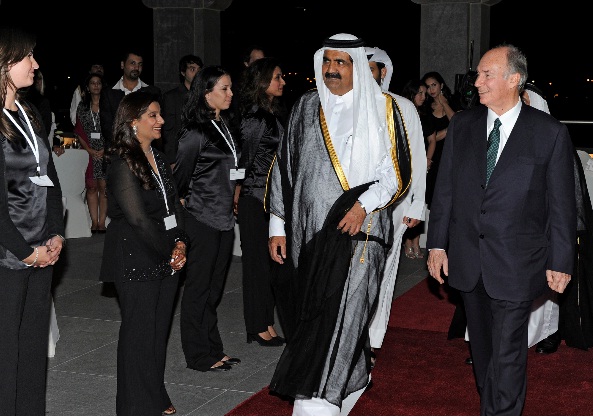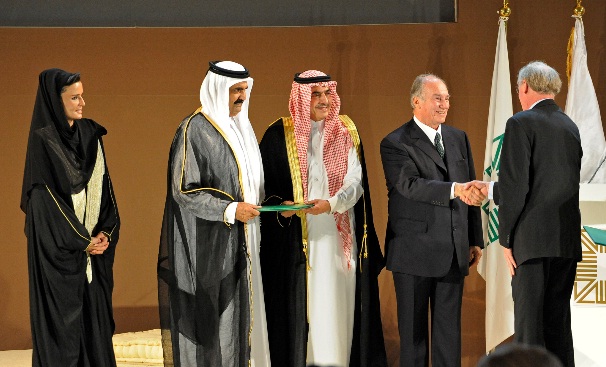Quick links
Other links
- November 24, 2010
 |
| His Highness the Aga Khan at the Aga Khan Award for Architecture 2010 Award Presentation Ceremony |
Bismillah-ir-Rahman-ir-Rahim
Your Highness the Emir
Your Highness Sheikha Moza bint Nasser
Excellencies
Distinguished Guests
Ladies and Gentlemen
As-salaam-o-aleikum
What a pleasure it is to greet this wonderful audience, including so many friends, old and new, who have helped shape this programme, and who are so essential to its future.
I am especially pleased to salute their Highnesses, the Emir of Qatar and Sheikha Moza. We are honoured by your presence - and grateful for your inspiring example, as you embrace this country’s proud heritage, while also pointing it boldly to the future.
It is hard for me to believe that this Awards process is now a third of a century old! - and that it has involved some 3500 candidate projects and over 100 prize recipients. As we complete the 11th cycle, I am delighted to extend to all of our recipients my warmest congratulations!
The awarding of prizes is in the spotlight tonight - and deservedly so. But the prizes themselves are only the tip of a larger iceberg. The Awards programme also includes a wide array of seminars, exhibitions, lectures, publications and a highly decentralized selection process. This ceremony, in short, marks the culmination of a long and lively conversation.
Many of you will remember my personal concern, back in the mid-1970’s, that this conversation was scarcely even taking place.
Discussion and debate about the built environment in the Islamic world was then a very thin proposition. The continuity of Islamic architecture had sadly lapsed - weakened by the heavy hand of colonialization, by modernization and globalization, by the lack of architectural training in Islamic contexts, and even by the development of new construction materials in the industrialized world. The result was a paucity both of indigenous architects and of foreign architects working with distinction in Islamic settings and idioms.
At that time I used the term “vacuum” to describe the Islamic architectural scene. The initial goal of our Awards programme was to replace that vacuum with an energized debate. Was there a problem, how could it be addressed, by whom, and in what settings?
Notice that we did not seek then - nor do we now - the advancement of some definitive aesthetic style, or the promulgation, as one colleague put it, of some “manifesto of architectural intent.” What we cared most about was that relevant questions be raised, and that a broad range of constituents be engaged in discussing them.
Three decades later, we can claim considerable progress, stimulated by this Award and other endeavours with similar goals.
We have come a long way from a careless confidence that the built environment would somehow take care of itself. We are increasingly aware that the quality of our buildings can transform the quality of our lives, both spiritual and material.
We have only to look around us tonight to see how things have changed. This Museum of Islamic Art itself represents one of the high profile accomplishments in global architecture in recent years. It symbolizes how contemporary international talent, at the highest level, can join creatively with ancient cultural inheritance - and visionary national leadership.
This Museum represents a commitment we have seen elsewhere in Doha - from the development of the Qatar National Museum - one of our first prize recipients in 1980, to the reconstruction of Souq Waqif - one of 19 prize finalists this year - to the striking new structures of Education City. And the progress we see in Qatar now is echoed through much of the Islamic world. How much the Aga Khan Awards have contributed to this story is for others to judge - but I do believe that our recipients, through the years, have provided inspiring examples of architectural excellence.
But what comes next? As we look to the future, let me mention four principle areas of concern: the Islamic environment of our work, its relevant constituencies, the shifting social and economic scene, and the impact of new technologies.
My first concern is with the cultural context of our work. Why should we emphasize an Islamic approach to architecture? Our Master Jury, in responding to this question, has described how global forces now threaten the values of “memory, heritage and belonging,” and how the built environment can help meet that challenge. This is why these triennial celebrations take place in settings that evoke Islamic tradition, and why most of our Award juries have thereby emphasized, among other criteria, the restoration and reutilization of historic buildings. Great icons of the past must not be allowed to disappear, without an opportunity to come back to life and serve the future.
At the same time, in looking at the places we have met and the projects we have honoured, we also see enormous diversity. Diversity, in fact, is part of the essence of Islam. The unity of the Ummah does not imply sameness. Working in an Islamic context need not confine us to constraining models.
Nor does respecting the past mean copying the past. Indeed, if we hold too fast to what is past, we run the risk of crushing that inheritance.
The best way to honour the past is to seize the future.
In sum, an Islamic architectural agenda involves a dual obligation - a heightened respect for both the traditions of the past and the conditions of the future.
The answer is increasingly complex. The architectural community has been expanding - beyond the creative core of professional architects.
The list of players is long: planners and managers, engineers and financiers, researchers and educators, computer scientists and social scientists, designers and craftsmen, political and civic leaders, clients and consultants.
More players mean more variables to consider - not only creative designs, but also client directives, the adaptability of building types and materials, allowed expenditures, the indigenous climate, rural versus urban settings - and, of course, the immediate cultural context. We must be aware, for example, that Islamic populations are intermingled, more and more, among peoples of other backgrounds.
When I think of the diversified players in the architectural community, I am reminded of the impatient client who wrote to his architect: “Awaiting plans. If good - cheque will follow.” To which the wise architect, of course, replied: “Awaiting cheque! If good - plans will follow!”
Indeed it takes a wonderful mix of patience and impatience to achieve architectural success.
In the end, significant progress will require the effective interplay of all constituent groups. The success of each is diminished when any of them lags - in concern or in competence.
As we define our constituencies more inclusively, we can help raise architectural awareness across a wider spectrum of stakeholders.
A third area of growing concern is the shifting social and economic scene. People are living longer, rural populations are urbanizing, and economies are diversifying, making complex demands on the built environment. This is why societal evolution has become a stronger preoccupation for our nominating juries. The fact that an industrial complex, for the first time, is one of our Award winners tonight is welcome evidence of this growing recognition.
The nature of the Award is to help shape best practices for the built environments of Muslims and their neighbors. Our mandate must therefore include a wide range of architectural settings - not only mosques, museums and monuments - but also schools and hospitals, industrial spaces and public markets, parks and thoroughfares, and, of course, a variety of residential habitats.
Similarly, our geographical focus must be more inclusive. For centuries, most of our important buildings have been located in capital cities. But recent population growth has concentrated in what I would call secondary cities, often neglected by the global spotlight, but in need of intelligent planning.
The same thing is true in rural settings, which have often been left to a self-build process, receiving little best-practice attention. This, too, is a situation which the Award process can help redress, as we adapt to social realities.
Fourth, and finally, let me point to the revolutionary impact of new technologies. Clearly, a relevant architectural conversation these days requires a considerable degree of technological sophistication, as we encounter a constant flow of new materials, new techniques, and new requirements.
Among other things, new technologies can help us address growing environmental urgencies. I think, for example, of the pressing need for energy and water conservation, and of the risks associated with climate change, weather extremes and geological instability. Used alertly and intelligently, new technologies can help us cope with bewildering environmental challenges.
These, then, are four of the major concerns that I would submit for further discussion. What does architectural excellence mean in the context of Islamic traditions and aspirations? How do we reach a wider array of constituents? Can we expand our social and economic relevance? And how do we best employ innovative technologies?
These concerns, of course, will lead us to further questions. How and where do we teach about architecture? How can we anticipate and occasionally help steer the processes of change? How do we best reward and learn from those who are most successful? How can we share our lessons with others outside the Ummah?
In addressing all these issues, I believe we can, indeed, make our continuing conversation more relevant and more productive - remembering always the Quranic commandment that humankind must take responsibility for shaping and reshaping our earthly environment, employing Allah’s gifts of time and talent as good stewards of His Creation.
Thank you.
Speech and photos source: AKDN.org

Muslim CelebrationsMuslim Holidays and Festivals
| Present Imam Shah Karim Aga Khan IV| 48th
Imam Mowlana Sultan Mahomed Shah Aga Khan III | Hazrat
Ali | Prophet
Muhammad | Ismaili
Heroes | Navigation Tool
| Poetry
| Audio Page | History
| Women's Page
| Legacy of
Islam | Current Events
|
 Back to Ismaili Web
Back to Ismaili Web
